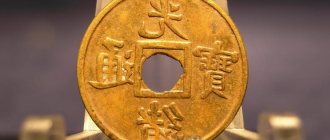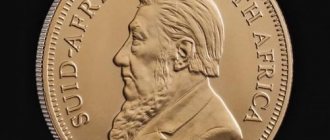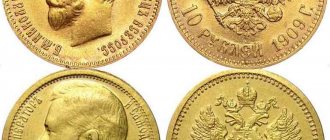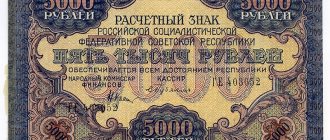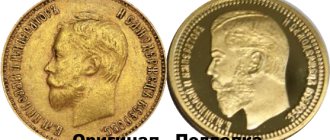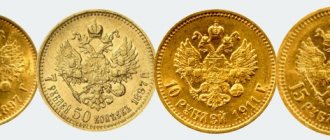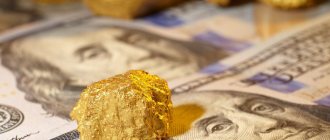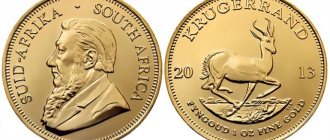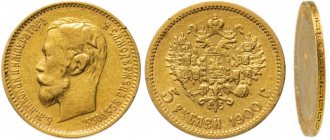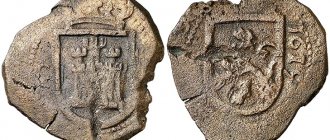Post updated: Jul 19, 2020
Numismatists have their own definitions of the value of certain coins. It is often not clear to an ordinary person why the price does not correspond to the one he independently calculated. In fact, the weight of gold in a coin is divided into the total and the pure precious metal contained in it, and the difference between them is called a coin foot.
The mass of gold in a coin is called a corn (translated from German as grain). Moreover, this definition is used not only in relation to gold, but also to any other precious metal, for example, silver. Korn is used to calculate the price of coins in cases of containing impurities of other metals.
In other cases, the value of a coin is calculated by its total weight. But most often it turns out that there is a significant difference between the net and total weight.
History of coin units
A silver or gold coin of the tsarist era often has a weight measure that is not quite familiar to modern times in the form of “3 spools and seventy-eight shares” or “one spool and 56 shares.” And on banknotes of the late 19th and early 20th centuries there was an inscription: “1 ruble is equal to 17.424 shares of pure gold.” They began to measure gold and other precious metals in grams only closer to the twenties of the last century, and before that slightly different measures of measurement were in use.
Weight of Russian coins
Like the Europeans, the Russian people in coinage were guided by the value of the precious metal, accepting coins of neighboring states not by face value, but by weight. It was not the banknote of a foreign power itself that was evaluated, but the gold and silver in its composition. Until the 18th century, most domestic coins were minted from silver. The method by which the minting was carried out is called wire: a piece was pinched off from a silver wire, flattened or melted, and then struck with a hammer - a hammer, on the striking part of which a drawing or inscription was carved. Due to their characteristic appearance, numismatists call these coins “scales.” After the reform of Elena Glinskaya, 300 kopecks, or 600 money, or 1200 half rubles were minted from a silver hryvnia.
As a result of the reform of Elena Glinskaya, a unified monetary system emerged in Rus', in which 300 kopecks, or 600 money, or 1200 half-shek, were minted from a hryvnia of silver weighing 204 grams. Therefore, a penny of that time weighed 0.68 grams, money - 0.34 grams, and a half - 0.17 grams.
Subsequently, with a shortage of silver, the penny began to lose weight, or, as they say, “lose weight.” They tried to solve the problem of silver shortage by introducing copper money into circulation, but without success, and one of these attempts led to a copper riot. Only Peter the Great succeeded in introducing copper coins into circulation. The first half coin and money made of copper appeared in 1700. The copper penny was added in 1704, although the tiny silver penny (0.28 grams) continued to be minted until 1718. The issue of copper money was also subject to weight standards. The coin stack (the number of coins of the same denomination that is minted from a certain weight) was strictly regulated and could only be changed by decree of the emperor or empress. In the Russian Empire, from a pound of copper (16.38 kg), at different periods a coin was minted in the amount of:
- 1700-1702 – 12 rubles 80 kopecks
- 1702-1704 – 15 rubles 44 kopecks
- 1704-1718 – 20 rubles
- 1718-1730 – 40 rubles
- 1730-1755 – 10 rubles
- 1755-1757 – 8 rubles
- 1757-1762 – 16 rubles
- 1762-1763 – 32 rubles
- 1763-1810 – 16 rubles
- 1810-1830 – 24 rubles
- 1830-1839 – 36 rubles
- 1839-1848 – 16 rubles
- 1849-1867 – 32 rubles
- 1867-1917 – 50 rubles
The last domestic copper kopecks were issued under the USSR in 1924. Their mass exactly corresponded to the similar denominations of Nicholas II. But soon the weight value of the metal ceased to play a major role. Small denominations are minted from light aluminum bronze, having significantly decreased in size, and silver is no longer used in the manufacture of large ones. Since then, the weight and size of settlement signs have been calculated based on their ease of handling.
Old Russian types of units of measurement
From 1747 to 1920, all units of measurement could be equated to the Russian pound. One Russian pound meant a mass equal to 0.4095124 kg (409.5124 g). At the moment, you can find information about many other types of feet, such as Austrian, Venetian, French and others, the values of which are very different from the Russian pound.
Chervonets
1 chervonets was equal to one spool and its 78.24 share was pure gold.
If we were talking about large volumes of precious metals or other materials, their weight was measured in a unit of measurement such as a pound. One pood is equal to forty pounds. The heaviest copper coin of the time of the Russian Empire was one ruble from 1725 - its weight was a tenth of a pood, that is, a little more than 1.6 kg. Gold in coins was measured in even smaller units: spool, lot and share.
The very concept of “zolotnik” most likely comes from the gold coin “zolotnik”, which was in circulation in Kievan Rus. Zolotnik (“zlatnik”) was a small gold coin. One pound was equal to ninety-six spools, and one spool was equal to 96 shares. Such a division into 96 parts shows the influence (although not the most obvious) of the sixfold number system that existed in ancient times, which influenced the measurement of length, time and some others.
Soviet chervonets 1923.
The term “spool” was also used to determine the purity of gold. For example, if a 1-spool coin contained a pure gold weight of 75 parts of 21 parts of the total alloy, then the coin was considered to be made from 75-carat gold or "75-spool gold." Nowadays, the sample of precious metals is displayed in ppm (this is the value of the part of pure metal per one thousand parts of the alloy). Because of this, various old gold items are of low purity.
Zolotnik of Kievan Rus.
The fraction was the smallest unit of mass measurement and was equal to 1/96 of the spool, otherwise 44.435 mg (0.044435 g). The lot was used in the second half of the 18th - early 20th centuries and was equal to 1/32 of a pound or three spools.
Old Russian measurement values were also used on gold chervonets, which were produced in 1923 and 1975-1982. The mass of pure gold in such a coin is one spool and 78 shares.
One troy ounce bar.
Based on the presented data, the ratio of the old Russian values of the weight measure can be represented as:
- One pood is equal to forty pounds and is equal to 16380.496 grams;
- One pound is equal to thirty-two lots or ninety-six spools or 9216 shares and 409.5124 grams;
- One lot is equal to three spools or 288 shares or 12.79728 grams;
- One spool is equal to ninety-six shares = 4.26576 grams;
- One fraction is equal to 0.044435 grams;
GBP
Now this is a familiar coin for calculations, and it seems to most of our contemporaries that it has always been this way. But in coin form the age of the pound is extremely modest. But its history as a unit of weight is very long. It is necessary to distinguish between the types of pounds, of which the London, tower (Tower) and Troy (gold coin) pounds are distinguished. The standard English pound, for example, is equal to 16 troy ounces (453.592 grams), and the gold coin pound is 12 troy ounces (373.242 grams).
The origin of the word “pound” comes from the Latin “pondus” (“weight”). Why is the UK currency called “pound sterling”? According to the Oxford Dictionary, this is a monetary unit of weight. One pound of silver was minted into 240 sterlings. Shown above is a Norman penny bearing the image of Offa (King of Mercia), which historians mistake for sterling. To check the quality of the coins brought by the buyer, the seller was required to weigh 240 of them, checking whether they amounted to a pound. At that time, the Tower pound was in use, equal to 349.9 grams. The name was given to it by the Tower of London, where the mint was located. However, in 1527, Henry VIII replaced this pound with the Troy pound. According to another version, the word “sterling” is the word “Easterling”, which denoted the lands occupied by the Hanseatic League, from where merchants sailed with coins made of high-grade silver. Gradually the name of the land became the name of the coin. The British proudly claim that the pound sterling is the oldest currency in the world, functioning continuously from the time of its creation to the present day.
For a long time, the pound sterling existed only as a monetary unit of account, and then in the form of a banknote. Although it always retained the status of a “heavy” currency, inflation gradually devalued it, like other major currencies of the world. In 1980, Great Britain came to terms with the idea that the pound had become noticeably “lighter” and that the one-pound note should be replaced by a coin. The first one pound coins were minted in 1983 with a mintage of 443,054,000 copies. To prevent the pound from being confused with other coins, it was given a yellowish tint by adding zinc to the alloy, and a solid weight of nine and a half grams. On April 21, it entered circulation.
Over time, they learned how to skillfully counterfeit this coin. Authorities have sounded the alarm, claiming that up to three percent of the coins in circulation are counterfeit. Therefore, the Royal Mint, using the latest technologies in minting, is now producing a new type of pounds. The ideally round shape was replaced by a dodecahedron, the coin became bimetallic, and modern degrees of protection appeared. On the reverse, the British crown combines four plants symbolizing the four parts of the United Kingdom - England, Scotland, Wales and Northern Ireland.
Modern unit of measurement of the mass of precious metals
From 1977 to the present day, various commemorative and commemorative coins have been issued from different types of precious metals.
They are minted weighing one troy ounce, or 31.1034768 grams. This name comes from the French city (Troyes).
This value is now used in the banking and jewelry industries when measuring precious metals, as well as in other areas, such as cosmetology, where the troy ounce denotes the weight of some very valuable components. Around the world, the troy ounce, gold, silver, platinum and palladium are denoted by the following abbreviations: XAU, XAG, XPT, XPD. The mass of larger coins (more than 1 kg) is measured in grams.
Grand
And finally, one more weight unit, on the basis of which the minting of US coins was built. Gran comes from the Latin “granum” (grain, grain) and is indeed based on the weight of the barley grain. This unit of weight is now considered obsolete. Unlike gram (g), gran is denoted by two letters (gr). In Russian, the abbreviation of gram as “g” and “gr” has long been accepted, and the whole difference is from the designation of grana in the dot. Basically, pharmacists used grains to measure the dosage of the drug. Now this unit continues to be used in Anglo-Saxon countries, where grains indicate the weight of the bullet and gunpowder in the cartridge.
On April 2, 1792, the US Congress adopted the Coinage Act, which determined the rules for minting money in the newly formed country and the mass of metal that would be used to make a specific denomination. The table shown above describes three denominations of gold coins, five silver coins and two copper coins. All coin metals are not surprising, since at that time the leading powers of the world used this three, and the denomination was strictly tied to weight.
One of the most expensive coins in the world is the first US dollar. Its production faced great difficulties. The approved standard in the form of 892 was abandoned: mint employees argued that such an alloy was difficult to produce, and coins made from it would quickly darken in circulation. Therefore, while maintaining the total coin weight of 416 grains indicated in the Coin Act, the sample is increased to 900 grains. But then the pure mass of the metal began to contradict the law. It would seem, what's wrong? However, suppliers of the precious metal began to incur losses due to the increase in purity, because they exchanged bullion for minted dollars, based on the Coin Act. For example, John Vaughan estimated his losses on the supply of silver to the mint at $2,260 and by the beginning of the 19th century he had awarded himself compensation.
The fate of the first cents turned out to be no less difficult. The Coinage Act specified the copper content of the one-cent coin at 264 grains (17.1 grams). However, after trial minting, it was discovered that such large and heavy coins were unlikely to be convenient for circulation. Shown above is an original way out of the situation - bimetal: a piece of silver was pressed into the center of a copper billet. The total cost of silver and copper was equal to the price of the copper coin specified in the Coin Act. Due to the complexity of production, this method was not used. But they decided to lose weight anyway. From 1793 to 1795 the 1 cent coin weighs 208 grains (13.48 grams), and from late 1795 to 1857 it was minted from pure copper weighing 168 grains (10.89 grams).
How much do Bank of Russia coins weigh?
Modern coins also have accurate weight characteristics. Of course, an individual specimen may deviate from the standard value, but the deviations will be within the acceptable range.
- 1 kopeck - 1.5 grams
- 5 kopecks - 2.6 grams
- 10 kopecks (1997-2006) - 1.95 grams
- 10 kopecks (2006-2015) - 1.85 grams
- 50 kopecks (1997-2006) - 2.9 grams
- 50 kopecks (2006-2015) - 2.75 grams
- 1 ruble (1997-2009) - 3.25 grams
- 1 ruble (2009-present) - 3 grams
- 2 rubles (1997-2009) - 5.1 grams
- 2 rubles (2009-present) - 5 grams
- 5 rubles (1997-2009) - 6.45 grams
- 5 rubles (2009-present) - 6 grams
- 10 rubles - 5.63 grams
- 10 rubles bimetal (2000-2016) - 8.4 grams
- 10 rubles bimetal (2017-present) - 7.9 grams
- 25 rubles – 10 grams
When determining the mass of a specific coin, one must remember that in 2006 the Bank of Russia abandoned the minting of the ten-kopeck piece and the fifty-kopeck piece in non-magnetic brass and switched to magnetic steel with plating. In 2009, magnetic steel with galvanic coating was also used for minting ruble denominations.
Weight of Russian coins in grams
Why is weight given so much attention? Because this is the most important indicator of the authenticity of the coin being examined. When displaying a copy on a numismatic forum, do not be surprised by the stern question “Where is the photo on the scale?” The weight of the Peter's ruble is 28 grams. , under Catherine the Great, a ruble weighs 24 grams. , and the ruble of the last emperor of Russia weighs 20 grams. If the tested scales show serious deviations from the weight norm, then something is wrong with the coin. Adjusting the mass to the true value has always been a rather difficult task for counterfeiters. They had to vary either the diameter or the thickness of the “product”. Nowadays, when the numismatic market is overflowing with copies, weighing a coin is a mandatory safety precaution when purchasing. Where can I find out the exact weight of Russian coins? To do this, use only verified catalogs (including electronic ones). The Rarity project is an extensive electronic catalog of coins from Russia and around the world, where you can find out the weight of any coin.
